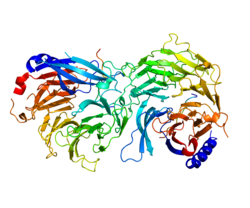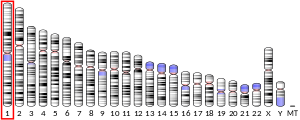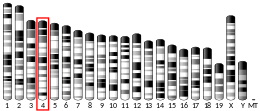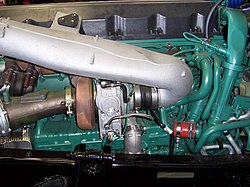히스톤 결합 단백질 RBBP4(RbAp48 또는 NURF55 )는 사람 에서 RBBP4 [5] [6] 단백질 이다.
기능. 이 유전자는 WD-반복 단백질 의 고도로 보존된 아족에 속하는 보편적으로 발현되는 핵단백질을 암호화한다. 히스톤 아세틸화 와 염색질 조립에 관여하는 단백질 복합체에 존재한다.이는 히스톤 탈아세틸화와 관련된 염색질 리모델링 및 전사 억제와 관련된 Mi-2/NuRD 복합체의 일부이다. 이 암호화된 단백질은 또한 전사 소음의 필수 구성요소인 코어프레서 복합체의 일부입니다. 그것은 세포 증식을 조절하기 위해 망막아종 단백질 에 직접 결합하는 여러 세포 단백질 중에서 발견됩니다. 이 단백질은 또한 E2F 반응 [7]
임상적 의의 뇌 해마 의 치상회 (DG)에서의 RbAp48의 감소는 정상적 인 [8] 기억력 감퇴의 주요 원인으로 의심된다.RbAp48의 연령 관련 감소는 사람의 사후 조직 및 생쥐에서 DG에서 관찰된다. 또한 RbAp48의 우성 음성 형태의 유전자 녹인은 노령 생쥐에서 관찰된 것과 유사한 기억력 결핍을 어린 생쥐에서 유발한다. 마지막으로 뇌에서 RbAp48의 발현을 증가시키기 위한 렌티바이러스 유전자 이식은 노령 [8]
RBBP4는 적어도 부분적으로 PKA-CREB1-CPB [8] 따라서 노화 관련 기억 상실을 회복하기 위한 하나의 가능한 치료적 접근법은 PKA-CREB1-CPB 경로 자극 약물의 사용이다. 앞서 아데닐시클라아제 및 cAMP 포스포디에라아제 억제제 롤립람과 양적으로 결합된 6-Br-APB , SKF-38, 393과 같은 도파민 D1/D5 작용제가 노화된 [9]
상호 작용 RBBP4는 다음과 상호작용하는 것 으로 나타났습니다.
레퍼런스 ^ a b c GRCh38: 앙상블 릴리즈 89: ENSG00000162521 - 앙상블 , 2017년 5월^ a b c GRCm38: 앙상블 릴리즈 89: ENSMUSG000057236 - 앙상블 , 2017년 5월^ "Human PubMed Reference:" . National Center for Biotechnology Information, U.S. National Library of Medicine .^ "Mouse PubMed Reference:" . National Center for Biotechnology Information, U.S. National Library of Medicine .^ Qian YW, Wang YC, Hollingsworth RE Jr, Jones D, Ling N, Lee EY (September 1993). "A retinoblastoma-binding protein related to a negative regulator of Ras in yeast". Nature . 364 (6438): 648–52. Bibcode :1993Natur.364..648Q . doi :10.1038/364648a0 . PMID 8350924 . S2CID 4303062 . ^ Barak O, Lazzaro MA, Lane WS, Speicher DW, Picketts DJ, Shiekhattar R (November 2003). "Isolation of human NURF: a regulator of Engrailed gene expression" . EMBO J . 22 (22): 6089–100. doi :10.1093/emboj/cdg582 . PMC 275440 PMID 14609955 . ^ "Entrez Gene: RBBP4 retinoblastoma-binding protein 4" .^ a b c Pavlopoulos E, Jones S, Kosmidis S, Close M, Kim C, Kovalerchik O, Small SA, Kandel ER (August 2013). "Molecular Mechanism for Age-Related Memory Loss: The Histone-Binding Protein RbAp48" . Sci Transl Med . 5 (200): 200ra115. doi :10.1126/scitranslmed.3006373 . PMC 4940031 PMID 23986399 . ^ Bach ME, Barad M, Son H, Zhuo M, Lu YF, Shih R, Mansuy I, Hawkins RD, Kandel ER (April 1999). "Age-related defects in spatial memory are correlated with defects in the late phase of hippocampal long-term potentiation in vitro and are attenuated by drugs that enhance the cAMP signaling pathway" . Proc. Natl. Acad. Sci. U.S.A . 96 (9): 5280–5. Bibcode :1999PNAS...96.5280B . doi :10.1073/pnas.96.9.5280 PMC 21855 PMID 10220457 . ^ Yarden RI, Brody LC (1999). "BRCA1 interacts with components of the histone deacetylase complex" . Proc. Natl. Acad. Sci. U.S.A . 96 (9): 4983–8. Bibcode :1999PNAS...96.4983Y . doi :10.1073/pnas.96.9.4983 PMC 21803 PMID 10220405 . ^ Zhang Q, Vo N, Goodman RH (2000). "Histone binding protein RbAp48 interacts with a complex of CREB binding protein and phosphorylated CREB" . Mol. Cell. Biol . 20 (14): 4970–8. doi :10.1128/MCB.20.14.4970-4978.2000 . PMC 85947 PMID 10866654 . ^ Feng Q, Cao R, Xia L, Erdjument-Bromage H, Tempst P, Zhang Y (2002). "Identification and functional characterization of the p66/p68 components of the MeCP1 complex" . Mol. Cell. Biol . 22 (2): 536–46. doi :10.1128/MCB.22.2.536-546.2002 . PMC 139742 PMID 11756549 . ^ a b Zhang Y, Dufau ML (2003). "Dual mechanisms of regulation of transcription of luteinizing hormone receptor gene by nuclear orphan receptors and histone deacetylase complexes" . J. Steroid Biochem. Mol. Biol . 85 (2–5): 401–14. doi :10.1016/S0960-0760(03)00230-9 . PMID 12943729 . S2CID 28512341 . ^ a b Yao YL, Yang WM (2003). "The metastasis-associated proteins 1 and 2 form distinct protein complexes with histone deacetylase activity" . J. Biol. Chem . 278 (43): 42560–8. doi :10.1074/jbc.M302955200 PMID 12920132 . ^ a b c Nicolas E, Ait-Si-Ali S, Trouche D (2001). "The histone deacetylase HDAC3 targets RbAp48 to the retinoblastoma protein" . Nucleic Acids Res . 29 (15): 3131–6. doi :10.1093/nar/29.15.3131 . PMC 55834 PMID 11470869 . ^ Grozinger CM, Hassig CA, Schreiber SL (1999). "Three proteins define a class of human histone deacetylases related to yeast Hda1p" . Proc. Natl. Acad. Sci. U.S.A . 96 (9): 4868–73. Bibcode :1999PNAS...96.4868G . doi :10.1073/pnas.96.9.4868 PMC 21783 PMID 10220385 . ^ You A, Tong JK, Grozinger CM, Schreiber SL (2001). "CoREST is an integral component of the CoREST- human histone deacetylase complex" . Proc. Natl. Acad. Sci. U.S.A . 98 (4): 1454–8. Bibcode :2001PNAS...98.1454Y . doi :10.1073/pnas.98.4.1454 PMC 29278 PMID 11171972 . ^ a b Hassig CA, Fleischer TC, Billin AN, Schreiber SL, Ayer DE (1997). "Histone deacetylase activity is required for full transcriptional repression by mSin3A" . Cell . 89 (3): 341–7. doi :10.1016/S0092-8674(00)80214-7 PMID 9150133 . S2CID 14233219 . ^ Ng HH, Zhang Y, Hendrich B, Johnson CA, Turner BM, Erdjument-Bromage H, Tempst P, Reinberg D, Bird A (1999). "MBD2 is a transcriptional repressor belonging to the MeCP1 histone deacetylase complex". Nat. Genet . 23 (1): 58–61. doi :10.1038/12659 . hdl :1842/684 PMID 10471499 . S2CID 6147725 . ^ a b c Zhang Y, Ng HH, Erdjument-Bromage H, Tempst P, Bird A, Reinberg D (1999). "Analysis of the NuRD subunits reveals a histone deacetylase core complex and a connection with DNA methylation" . Genes Dev . 13 (15): 1924–35. doi :10.1101/gad.13.15.1924 . PMC 316920 PMID 10444591 . ^ a b Zhang Y, Dufau ML (2002). "Silencing of transcription of the human luteinizing hormone receptor gene by histone deacetylase-mSin3A complex" . J. Biol. Chem . 277 (36): 33431–8. doi :10.1074/jbc.M204417200 PMID 12091390 . ^ Hassig CA, Tong JK, Fleischer TC, Owa T, Grable PG, Ayer DE, Schreiber SL (1998). "A role for histone deacetylase activity in HDAC1-mediated transcriptional repression" . Proc. Natl. Acad. Sci. U.S.A . 95 (7): 3519–24. Bibcode :1998PNAS...95.3519H . doi :10.1073/pnas.95.7.3519 PMC 19868 PMID 9520398 . ^ Zhang Y, Iratni R, Erdjument-Bromage H, Tempst P, Reinberg D (1997). "Histone deacetylases and SAP18, a novel polypeptide, are components of a human Sin3 complex" . Cell . 89 (3): 357–64. doi :10.1016/S0092-8674(00)80216-0 PMID 9150135 . ^ Hakimi MA, Dong Y, Lane WS, Speicher DW, Shiekhattar R (2003). "A candidate X-linked mental retardation gene is a component of a new family of histone deacetylase-containing complexes" . J. Biol. Chem . 278 (9): 7234–9. doi :10.1074/jbc.M208992200 PMID 12493763 . ^ Tong JK, Hassig CA, Schnitzler GR, Kingston RE, Schreiber SL (1998). "Chromatin deacetylation by an ATP-dependent nucleosome remodelling complex". Nature . 395 (6705): 917–21. Bibcode :1998Natur.395..917T . doi :10.1038/27699 . PMID 9804427 . S2CID 4355885 . ^ Qian YW, Lee EY (1995). "Dual retinoblastoma-binding proteins with properties related to a negative regulator of ras in yeast" . J. Biol. Chem . 270 (43): 25507–13. doi :10.1074/jbc.270.43.25507 PMID 7503932 . ^ Nicolas E, Morales V, Magnaghi-Jaulin L, Harel-Bellan A, Richard-Foy H, Trouche D (2000). "RbAp48 belongs to the histone deacetylase complex that associates with the retinoblastoma protein" . J. Biol. Chem . 275 (13): 9797–804. doi :10.1074/jbc.275.13.9797 PMID 10734134 . ^ a b Zhang Y, Sun ZW, Iratni R, Erdjument-Bromage H, Tempst P, Hampsey M, Reinberg D (1998). "SAP30, a novel protein conserved between human and yeast, is a component of a histone deacetylase complex" . Mol. Cell . 1 (7): 1021–31. doi :10.1016/S1097-2765(00)80102-1 PMID 9651585 . ^ Kuzmichev A, Zhang Y, Erdjument-Bromage H, Tempst P, Reinberg D (2002). "Role of the Sin3-histone deacetylase complex in growth regulation by the candidate tumor suppressor p33(ING1)" . Mol. Cell. Biol . 22 (3): 835–48. doi :10.1128/MCB.22.3.835-848.2002 . PMC 133546 PMID 11784859 .
추가 정보 "RBBP4 retinoblastoma binding protein 4 [Homo sapiens (human)]" . Home - Gene - NCBI National Center for Biotechnology Information (NCBI) . Retrieved 2013-09-06 .Bauw G, Rasmussen HH, van den Bulcke M, et al. (1990). "Two-dimensional gel electrophoresis, protein electroblotting and microsequencing: a direct link between proteins and genes". Electrophoresis . 11 (7): 528–36. doi :10.1002/elps.1150110703 . PMID 1699755 . S2CID 24768114 . Grozinger CM, Hassig CA, Schreiber SL (1999). "Three proteins define a class of human histone deacetylases related to yeast Hda1p" . Proc. Natl. Acad. Sci. U.S.A . 96 (9): 4868–73. Bibcode :1999PNAS...96.4868G . doi :10.1073/pnas.96.9.4868 PMC 21783 PMID 10220385 . Hassig CA, Tong JK, Fleischer TC, et al. (1998). "A role for histone deacetylase activity in HDAC1-mediated transcriptional repression" . Proc. Natl. Acad. Sci. U.S.A . 95 (7): 3519–24. Bibcode :1998PNAS...95.3519H . doi :10.1073/pnas.95.7.3519 PMC 19868 PMID 9520398 . Marheineke K; Krude T (1998). "Nucleosome assembly activity and intracellular localization of human CAF-1 changes during the cell division cycle" . J. Biol. Chem . 273 (24): 15279–86. doi :10.1074/jbc.273.24.15279 PMID 9614144 . Maruyama K; Sugano S (1994). "Oligo-capping: a simple method to replace the cap structure of eukaryotic mRNAs with oligoribonucleotides". Gene . 138 (1–2): 171–4. doi :10.1016/0378-1119(94)90802-8 . PMID 8125298 . Qian YW; Lee EY (1995). "Dual retinoblastoma-binding proteins with properties related to a negative regulator of ras in yeast" . J. Biol. Chem . 270 (43): 25507–13. doi :10.1074/jbc.270.43.25507 PMID 7503932 . Rasmussen HH, van Damme J, Puype M, et al. (1993). "Microsequences of 145 proteins recorded in the two-dimensional gel protein database of normal human epidermal keratinocytes". Electrophoresis . 13 (12): 960–9. doi :10.1002/elps.11501301199 . PMID 1286667 . S2CID 41855774 . Suzuki Y, Yoshitomo-Nakagawa K, Maruyama K, et al. (1997). "Construction and characterization of a full length-enriched and a 5'-end-enriched cDNA library". Gene . 200 (1–2): 149–56. doi :10.1016/S0378-1119(97)00411-3 . PMID 9373149 . Taunton J, Hassig CA, Schreiber SL (1996). "A mammalian histone deacetylase related to the yeast transcriptional regulator Rpd3p". Science . 272 (5260): 408–11. Bibcode :1996Sci...272..408T . doi :10.1126/science.272.5260.408 . PMID 8602529 . S2CID 25717734 . Tong JK, Hassig CA, Schnitzler GR, et al. (1998). "Chromatin deacetylation by an ATP-dependent nucleosome remodelling complex". Nature . 395 (6705): 917–21. Bibcode :1998Natur.395..917T . doi :10.1038/27699 . PMID 9804427 . S2CID 4355885 . Verreault A; Kaufman PD; Kobayashi R, Stillman B (1998). "Nucleosomal DNA regulates the core-histone-binding subunit of the human Hat1 acetyltransferase" . Curr. Biol . 8 (2): 96–108. doi :10.1016/S0960-9822(98)70040-5 PMID 9427644 . S2CID 201273 . Verreault A; Kaufman PD; Kobayashi R, Stillman B (1996). "Nucleosome assembly by a complex of CAF-1 and acetylated histones H3/H4" . Cell . 87 (1): 95–104. doi :10.1016/S0092-8674(00)81326-4 PMID 8858152 . S2CID 1416453 . Wolffe AP; Urnov FD; Guschin D (2001). "Co-repressor complexes and remodelling chromatin for repression". Biochem. Soc. Trans . 28 (4): 379–86. doi :10.1042/0300-5127:0280379 . PMID 10961924 . Yarden RI; Brody LC (1999). "BRCA1 interacts with components of the histone deacetylase complex" . Proc. Natl. Acad. Sci. U.S.A . 96 (9): 4983–8. Bibcode :1999PNAS...96.4983Y . doi :10.1073/pnas.96.9.4983 PMC 21803 PMID 10220405 . Zhang Y, Ng HH, Erdjument-Bromage H, et al. (1999). "Analysis of the NuRD subunits reveals a histone deacetylase core complex and a connection with DNA methylation" . Genes Dev . 13 (15): 1924–35. doi :10.1101/gad.13.15.1924 . PMC 316920 PMID 10444591 . Zhang Y, Iratni R, Erdjument-Bromage H, et al. (1997). "Histone deacetylases and SAP18, a novel polypeptide, are components of a human Sin3 complex" . Cell . 89 (3): 357–64. doi :10.1016/S0092-8674(00)80216-0 PMID 9150135 . Zhang Y, Sun ZW, Iratni R, et al. (1998). "SAP30, a novel protein conserved between human and yeast, is a component of a histone deacetylase complex" . Mol. Cell . 1 (7): 1021–31. doi :10.1016/S1097-2765(00)80102-1 PMID 9651585 . Zhang Y, LeRoy G, Seelig HP, et al. (1998). "The dermatomyositis-specific autoantigen Mi2 is a component of a complex containing histone deacetylase and nucleosome remodeling activities" . Cell . 95 (2): 279–89. doi :10.1016/S0092-8674(00)81758-4 PMID 9790534 . S2CID 18786866 . Zhang Y; Dufau ML (2003). "Dual mechanisms of regulation of transcription of luteinizing hormone receptor gene by nuclear orphan receptors and histone deacetylase complexes" . J. Steroid Biochem. Mol. Biol . 85 (2–5): 401–14. doi :10.1016/S0960-0760(03)00230-9 . PMID 12943729 . S2CID 28512341 . 






